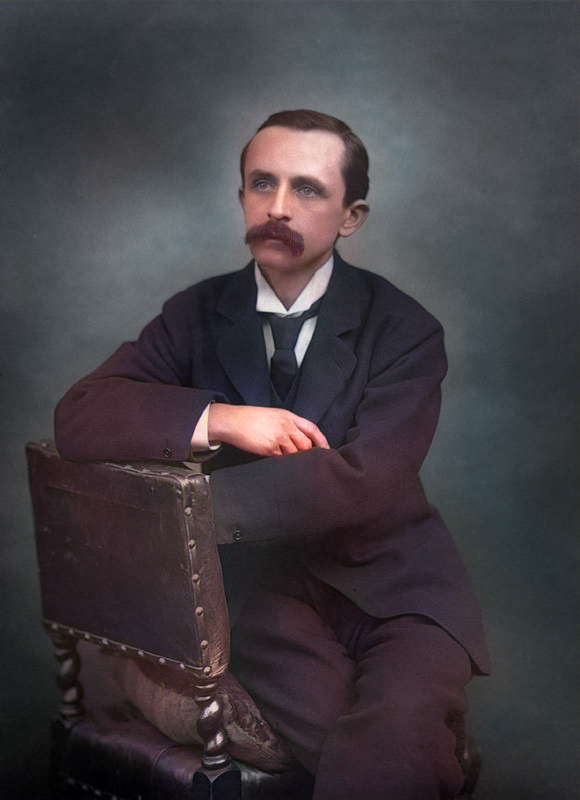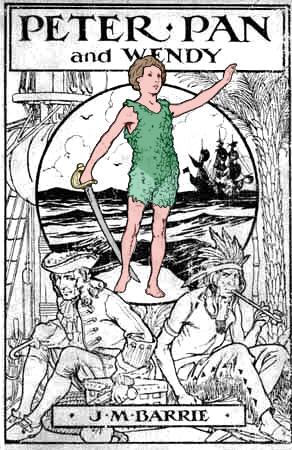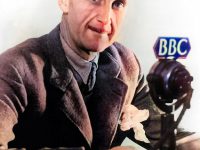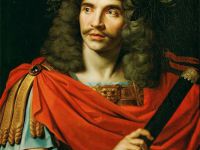
James Matthew Barrie (1860-1937), photo by Herbert Rose Barraud, 1892
On May 9, 1860, Scotish author and playwright Sir James Matthew Barrie, 1st Baronet was born. Barrie is best remembered for being the creator of Peter Pan in his novel “Peter Pan, or The Boy Who Wouldn’t Grow Up“, a “fairy play” about an ageless boy and an ordinary girl named Wendy who have adventures in the fantasy setting of Neverland.
“All children, except one, grow up. They soon know that they will grow up, and the way Wendy knew was this. One day when she was two years old she was playing in a garden, and she plucked another flower and ran with it to her mother. I suppose she must have looked rather delightful, for Mrs. Darling put her hand to her heart and cried, “Oh, why can’t you remain like this for ever!” This was all that passed between them on the subject, but henceforth Wendy knew that she must grow up. You always know after you are two. Two is the beginning of the end.”
– J. M. Berrie, Peter Pan and Wendy, 1911
James Matthew Barrie – Childhood and Education
James M. Barrie was born in Kirriemuir, Angus, Scotland as the ninth child and third son of David and Margaret Barrie (née Ogilvy). His father was a weaver. His mother encouraged him to educate himself by reading. When he was six years old, his older brother David died in an ice-skating accident just before his 14th birthday. It is said that their mother was so devastated by the sudden death that Barrie tried to fill David’s place in his mother’s attentions. It is further believed that he even started wearing David’s clothes and acted in a similar manner. Barrie later retold that his mother probably found comfort in the believe that her dead child would remain a young boy forever and never grow up.
J. M. Barrie was first educated at The Glasgow Academy where his elder siblings Alexander and Mary Ann taught. When he was 14, he enrolled at Dumfries Academy, again under the watch of Alexander and Mary Ann. During his early school years, Barrie started reading enthusiastically and liked the works of Robert Michael Ballantyne and James Fenimore Cooper as much as Penny Dreadfuls. Barrie attended the University of Edinburgh and received his M.A. degree in 1882.
Becoming a Writer
Following his education, Barrie worked as a journalist for the Nottingham Journal and began submitting pieces to the newspaper St. James’s Gazette. He became quite successful in the beginning and ended up writing a series of the stories he and his mother told when he grew up. They also served as the basis for his first novels, Auld Licht Idylls, published in 1888, A Window in Thrums, published two years later, and the 1891 novel The Little Minister.
And then a Theatre Writer
Later on J. M. Barrie‘s enthusiasm turned to works for the theatre. He started out with a biography of Richard Savage, which was followed by Ibsen‘s Ghost. Further, Barrie authored Jane Annie, a comic opera for Richard D’Oyly Carte which unfortunately failed. He then asked his friend Arthur Conan Doyle to revise and finish it for him.[6]
Peter Pan
The famous Peter Pan character first appeared in The Little White Bird (or Adventures in Kensington Gardens). The novel was published in 1902 and serialised in the US in the same year in Scribner’s Magazine. However, his most famous and enduring work Peter Pan, or The Boy Who Wouldn’t Grow Up had its first stage performance on 27 December 1904.

J.M. Berrie, Peter Pan and Wendy, Cover Illustration, (1915)
Childhood vs Adult Responsibility
The play describes the conflict between childhood and the responsibilities as an adult. As Peter had chosen not to grow up, he also tries to convince other kids to do the same. Another conflict of the play deals with the slightely romantic aspects of Peter and Wendy’s relationship. One the one hand, there is Peter’s desire for a mother figure and on the other hand, there is Wendy’s desire to kiss Peter. In general, the boy has conflicting feelings for Tiger Lily, and Tinker Bell, who each represent different female archetypes, and Captain Hook. The original stage production took place at the Duke of York’s Theatre, London, on 27 December 1904. The production was a great success and a production in New York City was performed at the Empire Theatre in 1905.
Interpretation
The end of the novel version clearly shows an ambivalence: Peter can only preserve his childhood, only remain unchanged by the fact that he soon forgets everything else, everything changeable, even if it was once very important to him. When he meets Wendy again after a year, he no longer remembers Captain Hook or even Tinkerbell, who in the meantime, as the reader learns, has probably died. He soon forgets Wendy, too, and when he finally returns, Wendy is grown up and has a daughter of her own who takes her place as Peter’s “mother”. Peter Pan is also an allegory for infantility, for the refusal to become adult and mature. Instead, he finds himself in a strange, unreal and floating lightness. This transitional problem from childhood to adolescence is therefore also a topic of psychoanalysis, especially in child and adolescent psychotherapy. This phenomenon is also known as Peter Pan syndrome, so named by the psychotherapist Dan Kiley.
Later Years
The Peter Pan character was inspired by the children George, Jack, Peter, Michael and Nico of his friend Sylvia Llewelyn-Davies. After the death of his mother in 1910, Barrie took care of the five boys and raised them. As a friend of children, Barrie bequeathed all rights to the books, films and plays of Peter Pan to Great Ormond Street Hospital, a London children’s hospital. His final play was The Boy David (1936), which dramatised the Biblical story of King Saul and the young David. Barrie died of pneumonia at a nursing home in Manchester Street, Marylebone on 19 June 1937.
Jordan Peterson – The Tragic Story of the Man-Child, [9]
References and Further Reading:
- [1] J.M. Barrie Information Website
- [2] Frampton’s pepert Pan Statue at the Victorian Web
- [3] Images from the Production of Peter Pan
- [4] Arthur Conan Doyle and J.M. Berrie
- [5] J.M. Barrie Biography at Famous Aurhors
- [5] J. M. Barrie at Wikidata
- [6] Elementary, my Dear Watson! – Sir Arthur Conan Doyle and his famous Sherlock Holmes, SciHi Blog
- [7] Works by or about J. M. Barrie at Internet Archive
- [8] “Why J. M. Barrie Created Peter Pan”, Anthony Lane, The New Yorker, 22 November 2004
- [9] Jordan Peterson – The Tragic Story of the Man-Child, 2017 Maps of Meaning 06: Story and Metastory (Part 2), Jordan B Peterson @ youtube
- [10] Law, Cally (10 May 2015). “Return to Neverland”. The Sunday Times.
- [11] Timeline for J. M. Berrie, via Wikidata





